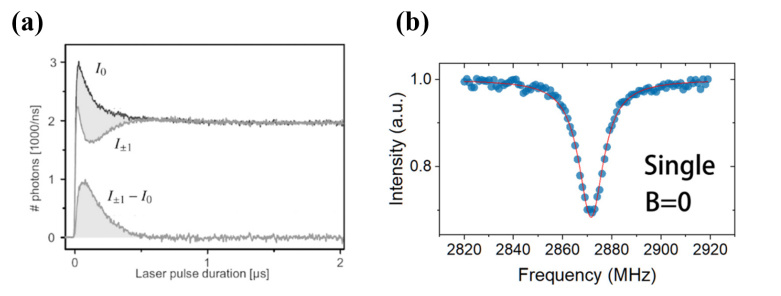Quantum Sensing with NV center in diamond
The NV center (Nitrogen-Vacancy Center) is a point defect in the diamond lattice, formed by a nitrogen atom substituting a carbon atom and combining with a vacancy at an adjacent site. It possesses a unique electronic structure and energy level distribution, with stable optical and spin properties at room temperature. This makes the NV center an ideal quantum sensor, widely used in high-precision measurements of physical quantities such as magnetic fields, electric fields, temperature, and pressure.


Figure 1. NV Center. (a) Atomic structure of the NV center. (b) Energy level structure of the NV center.
The quantum state of the NV center can be manipulated using optical and microwave methods. Optical excitation can initialize the spin state of the NV center to the m_s=0 state, while microwave radiation can induce transitions between different spin states. Due to the presence of intermediate energy levels (Figure 2(b)), the fluorescence intensity of the NV center varies for different spin states (m_s = 0, ±1 ). Thus, the spin state of the NV center can be distinguished by the intensity of its fluorescence. This technique of optical polarization and readout combined with microwave spin state manipulation is known as Optically Detected Magnetic Resonance (ODMR). It is a powerful and flexible experimental tool that combines the advantages of optical and magnetic resonance techniques, providing precise information at the nanoscale and forming the foundation of NV center-based quantum sensing.

Figure 2. (a) Time-resolved fluorescence of the NV center for different spin states; (b) ODMR spectrum of the NV center.
Applications of NV Centers in Quantum Sensing
Quantum sensing refers to methods that utilize the principles of quantum mechanics to achieve ultra-high precision measurements. Compared to classical measurement methods, quantum sensing has significant advantages in sensitivity and resolution, thereby showing broad application prospects in various fields such as physics, materials science, and biomedicine. By precisely measuring small physical quantities, scientists can explore the fundamental laws of nature and promote technological progress and innovation. Nitrogen-Vacancy (NV) centers, due to their multi-physical field detection capabilities and high sensitivity, have a wide range of applications in the field of quantum precision measurement.
NV centers can perform high-sensitivity magnetic field detection under room temperature conditions. Their working principle is based on the Zeeman effect of spin states under the influence of an external magnetic field. By measuring the changes in photoluminescence intensity, the magnetic field strength can be determined. The magnetic field measurement sensitivity of NV centers is extremely high, reaching the level of nanotesla (nT) or even picotesla (pT). This high sensitivity allows NV centers to detect single nuclear spins. Additionally, the size of NV centers is at the nanometer scale, enabling high spatial resolution magnetic field imaging. Due to the magnetic effect of currents, NV centers can also measure currents.
The magnetic field measurement and imaging technology of NV centers have applications in various fields, including intracellular magnetic field detection in biology, the study of the structure of magnetic materials in materials science, and research on spin dynamics and quantum coherence in fundamental physics.

Figure 3. (a) NV center observing antiferromagnetic domains in CuMnAs. (b) NV center neuronal magnetic imaging.
NV centers also exhibit high sensitivity to electric fields. Electric fields induce Stark effects in NV center energy levels, and by detecting changes in photoluminescence spectra, the intensity and direction of electric fields can be measured. This technology has important applications in microelectronic devices and materials science research, crucial for the development and testing of next-generation semiconductor devices. Furthermore, using NV centers for nanoscale electric field measurements provides a new tool for electrochemical processes and materials science research.
The fluorescence intensity and spectral position of NV centers are sensitive to temperature changes. By measuring these parameters' variations, high-precision temperature measurements can be achieved. This technique is particularly suitable for temperature monitoring in micro/nanoscale environments and biological samples. Due to the excellent biocompatibility of diamonds, NV centers can be used for intracellular temperature monitoring, helping scientists understand thermodynamic processes inside cells. This technology is important in biomedical research, especially in studying disease mechanisms and drug effects.

Figure 4. NV center cellular temperature imaging
Recent research has explored the application of NV centers under high-pressure conditions, particularly in studying the behavior of Earth's interior materials and high-pressure materials science. NV center sensors can provide precise pressure and magnetic field data in extreme environments, offering new methods for research in these fields.
Summary
NV centers hold significant importance in quantum precision measurement, leveraging their unique physical properties and extensive application prospects to become vital tools in scientific research and technological development. Looking ahead, with ongoing technological advancements and deeper research, NV center quantum precision measurement is expected to achieve breakthroughs in more fields, driving the development of quantum technologies and bringing greater benefits to human society.
Reference
[1]Barry J F, Schloss J M, Bauch E, et al. Sensitivity optimization for NV-diamond magnetometry[J]. Reviews of Modern Physics, 2020, 92(1): 015004.
[2] Doherty M W, Manson N B, Delaney P, et al. The nitrogen-vacancy colour centre in diamond[J]. Physics Reports, 2013, 528(1): 1-45.
[3] Wörnle M S, Welter P, Kašpar Z, et al. Current-induced fragmentation of antiferromagnetic domains[J]. arXiv preprint arXiv:1912.05287, 2019.
[4] Hall L T, Beart G C G, Thomas E A, et al. High spatial and temporal resolution wide-field imaging of neuron activity using quantum NV-diamond[J]. Scientific reports, 2012, 2(1): 401.
[5]Kucsko G, Maurer P C, Yao N Y, et al. Nanometre-scale thermometry in a living cell[J]. Nature, 2013, 500(7460): 54-58.






